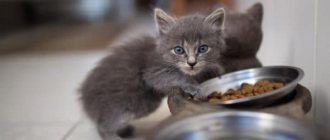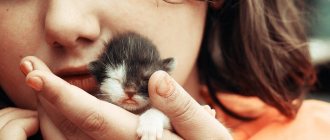The advisability of bathing
First of all, this is an opportunity to get rid of insects that parasitize a small pet. The active substances that make up industrial sprays, tablets and gels are quite aggressive. The baby’s immunity is just beginning to develop and any poisoning caused by toxic drugs can be fatal.
Bathing a kitten with flea shampoo is the only panacea for blood-sucking parasites. Therapeutic water procedures are especially important for purebred cats, for example, Scottish or British, because they have a very difficult time being around these insects.
Bathing
For reference! Some cat breeds love to swim and enjoy spending time in the water. Among them are Maine Coons, Bobtails, Egyptian Mau and Bengal cats.
Contraindications
Despite the apparent safety of this enterprise, it has a number of contraindications. The critical point is age. Under no circumstances should kittens under 3 months of age be allowed to participate in water procedures. During the washing process, skin lubricant dissolves, which opens up wide possibilities for dermatitis and other skin problems.
Swimming restrictions:
- Disease . If the kitten is sick (problems with the gastrointestinal tract, helminths, lichen, infections, etc.), then before bathing you should consult a specialist.
- Vaccination . Your pet should not come into contact with water for two weeks after any vaccinations.
- Surgical intervention . If there are fresh stitches on the body, then water procedures are strictly prohibited.
- Stress . When a cat is psychologically unstable, it cannot be treated with detergents and water. This will only aggravate stress and discourage your pet from water procedures.
At what age can you bathe a kitten?
Is it possible to bathe a kitten that is a week old or a little more? Absolutely not. Babies, unlike adults, are more vulnerable to diseases due to weak, immature immunity. Water violates the integrity of the protective film, which is fraught with the penetration and development of harmful microorganisms, including fleas.
There is no need to wash your pet for the first 2 months of life . All hygiene procedures, as well as cleaning from blood-sucking and other parasites, are undertaken by the kitten’s mother. If for some reason the latter is absent, then procedures can begin at 30 days of age.
At 3 months, the baby will already be stronger and bathing will not cause him any significant harm. Breeders do not recommend postponing the procedure to a later date. The older your pet gets, the more difficult it will be for him to get used to water. So the question: “When can you wash a kitten?” can be answered with confidence - upon reaching 3 months of age.
How often to wash?
Too frequent procedures deteriorate the quality of the coat. It is necessary to treat a kitten for fleas taking into account its breed, the specificity of its hair coat and its state of health. When it comes to pets that do not leave the apartment, they need to be bathed approximately 6 times a year .
Important! If fleas or worms appear, the procedure should be carried out immediately, even if the last contact with water was very recent.
As such, there are no restrictions in cats with little or no fur, like Sphynxes or Abyssinian cats. They get dirty noticeably faster, so the frequency of their bathing is reduced to once a month .
Prevention
It is up to the owner to prevent flea infestation. The recommendations will be as follows:
- It is necessary to limit the cat’s contact with street animals; in some cases, it is necessary to carefully monitor contacts with patients.
- Items used by your pet should be scalded with boiling water at least once a week.
- The animal must be brushed regularly using a special brush. Using a comb you can comb out not only fleas, but also parasite eggs.
- It is advisable to vacuum the floors in the apartment daily. This will help kill fleas living in carpets.
- The house must be wet cleaned monthly using antiparasitic agents.
Important! The owner also needs to be careful and attentive. If he stroked a neighbor's pet or a street cat, then upon arriving home he must wash his hands with soap.
Detergents
Regular soaps or shampoos will not work for humans. The kitten needs special products for bathing, and in case of flea infestation - containing active substances of a medical nature. In pet stores and veterinary pharmacies you can always find solutions depending on your situation and your budget.
Shampoos
Popular flea shampoos for kittens:
- Kiss;
- AVZ Elite Organic;
- Api-San;
- Beaphar;
- Lugovoy;
- Leopard.
Insecticide shampoos
Flea shampoos
When purchasing flea shampoo in a store, you need to carefully read the label, production dates and guarantees of this chemical product. Also, instructions are always added to them, telling in detail about its composition and principles of action, for cats of what age it can be used.
You can bathe kittens with flea shampoo only with a special one designed specifically for feline babies, because in high concentrations the chemicals can have harmful effects. Lugovoi, Bars and other shampoos have proven themselves well.
In addition to the main elements, various oils, plant extracts and minerals are also added to the shampoo, which help improve the structure of the cat's hair and its shine, which has a beneficial effect on the skin.
Insecticidal shampoos have varying degrees of effect on parasites depending on the age and weight of the cat.
When asked how often you can wash your cat with flea shampoo, you can answer: “depending on the situation.” Frequently washing and treating an animal is only possible if there are a large number of fleas in the fur. It is also necessary to check the instructions for the purchased product, which indicate the minimum period for re-processing.
How to properly bathe a kitten for the first time?
This is an important and responsible moment not only for the baby, but also for his owner. If the kitten does not experience stress the first time, then subsequent procedures will also take place without incidents - dissatisfied meowing and scratched hands.
Important! Breeders advise bathing the baby in a basin, and not in the bathtub. In such conditions it is much easier to hold it, and the pet will feel more confident in a small container.
Bathing process:
- Fill 2 basins with warm water so that it reaches the kitten’s belly.
- We cover the pet's ears with cotton pads, and it is also advisable to wear a harness.
- While stroking the kitten, we lower it into the basin.
- We scoop up the water with our hands and pour it over the baby.
- Add flea shampoo, lather and apply to the coat.
- Rinse the kitten in foam, and then in clean water.
After bathing, you need to wrap your pet in a towel, trying to squeeze out as much moisture as possible from the fur. After a couple of minutes, change it to dry. As soon as the water has drained, you can transfer the kitten to its usual environment - a house or to its mother cat. The latter itself will rid the baby of residual moisture.
Important! You cannot use the shower when bathing your pet. The kitten may be frightened by the strong jet and noise, which will discourage repeated procedures.
At what age and how to bathe a kitten
Bathing a cat is included in the list of hygiene procedures. However, with the exception of representatives of some breeds (Manx, Don and Canadian sphinxes, Abyssinian cats and some others), almost all cats have a negative attitude towards the bathing process; often performing water procedures ends in stress for the animal and scratched hands for the owner. To avoid such problems, you should accustom your pet to water from a very early age, and the very first bath is of great importance.
At what age can you bathe a kitten?
In the first weeks of a kitten’s life, all hygiene procedures are carried out by the mother cat; she devotes almost all her free time from feeding and sleeping to licking her babies, and in the future, the already grown-up kitten also carefully monitors the cleanliness of its fur. Despite this, most breeders agree that it is still necessary to wash the kitten, but this procedure should not be abused. The optimal time for the first procedure is considered to be the age after the change of baby teeth, that is, after three to four months. At this age, the baby is already quite strong, and his psyche will easily tolerate a new procedure for him. It is also necessary to bathe a kitten in the following situations:
- If any contamination gets on his fur, for example, the baby knocked over a cup of sunflower oil or a household chemical was accidentally spilled on him.
- A few days after purchase. You should not expose your baby to stress on the first day; you should give him time to get used to his new place of residence.
- A kitten picked up on the street is washed immediately after entering the house, regardless of its age, and products against skin diseases, fleas, ticks and other parasites must be used.
- Already from the age of three months, a purebred baby can take part in exhibitions in the kitten class, so 3-4 days before the event the kitten is bathed using cosmetics that give the fur an attractive appearance.
Too frequent bathing, especially with the use of shampoos, removes the protective fat layer from the baby's skin, so it is not advisable to bathe the baby unless absolutely necessary. For kittens of most breeds, two or three baths a year are sufficient; long-haired kittens with light fur can be washed a little more often.
How to bathe a kitten
The cat’s attitude towards water procedures throughout the rest of its life depends on how the first bath goes. Before bathing your cat, you should prepare the place for the procedure and place all the necessary tools and accessories within reach. It is also desirable for the kitten to run around, play enough, eat and be in a relaxed state and in a good mood. To carry out the procedure, it is worth hiring an assistant who will distract the kitten’s attention while the owner carries out the event as quickly as possible. Bathing can be done in a kitchen sink, washbasin, bowl or bathtub filled with 5-10 cm of warm (36-38°C) water. The procedure is performed as follows:
- Make small cotton swabs, moisten them with sunflower oil and protect the kitten’s ears from water with them. You can bathe your baby without such precautions, but in this case you will have to be extremely careful.
- Taking the withers, the kitten is placed in the water, and it does not matter whether he stands or sits.
- Continuing to hold the baby, moisten the fur with water from the shower head in the direction from neck to tail and apply shampoo evenly. The shampoo should not get into the eyes, ears or mouth of the animal.
- Rub the shampoo into the fur with gentle movements; the owner must be sure that the product gets not only onto the fur, but also onto the skin.
- Rinse off the shampoo thoroughly.
- Wrap the kitten in a towel that absorbs moisture well, leaving the head outside.
- After blotting the fur for 5-10 minutes (you should not dry the kitten, as this can damage the fur), release the pet onto a bedding or sofa.
While bathing, you should communicate affectionately with your baby, never raising your voice, and after the procedure, treat him with his favorite treat. You also need to ensure that there are no drafts in the room, and that the temperature does not drop below 22-24°C. You cannot bathe your baby earlier than 2 weeks after vaccination, or after illness or surgery.
Types of shampoos for kittens
You should not use soap or shampoos intended for humans to bathe kittens, as the level of acid-base balance in a cat is different from that of a human and the use of such products can lead to a deterioration in the quality of the coat or cause allergic reactions. It is also undesirable to use shampoos for adult cats, especially since veterinary pharmacies offer a wide range of products intended specifically for kittens. In addition to regular liquid shampoo, you can use products that perfectly cleanse your baby’s fur and skin without water treatments (dry shampoo or spray shampoo).
Before bathing your cat, you should carefully read the shampoo manufacturer's recommendations. In addition to universal products, there are shampoos on the market designed to care for kittens of certain breeds.
Basic rules for washing kittens
If you follow a number of simple rules, then during subsequent baths the kitten will experience noticeably less stress.
Recommendations:
- The procedure cannot be carried out immediately after eating.
- It is advisable to wash the kitten during its molting period.
- Before bathing, the coat must be combed and tangled.
- There should be no drafts in the processing area.
- For the first time, it is better to take unscented flea shampoo.
- The temperature in the basin should not exceed +40⁰С and not fall below +37⁰С.
- The head should be wetted with a sponge, not with water from your hand.
During the first bath, an assistant will also help: one person calms the baby, while the other performs all the necessary actions.
How to teach a kitten to bathe?
First of all, the owner himself needs to tune in. Cats feel people very subtly and the latter’s excitement is immediately transmitted to the animal. Therefore, before bathing a small kitten, you need to calm down and relax.
In the basin
Before filling the basin with water, you should put your pet in it and play with it so that it gets used to the environment. As soon as the baby gets comfortable, you can pour water. At the same time, it is very important to stroke the kitten, while talking to it in lower tones.
How to bathe a cat or kitten
Bathing a cat with shampoo
Before starting this procedure, you need to take into account that both small kittens and adult cats are often afraid of water procedures, and bathing is very stressful for them (although there are exceptions when they love to squish in the water and even jump into the washbasin for a bath ).
How to wash a kitten with flea shampoo - sequence of steps:
- Prepare: a small basin and a bottle of shampoo;
- The water should be warm (in no case hot);
- Place the baby in the basin, holding it with one hand (so as not to run away) and thoroughly moisten the fur;
Important!
When washing, do not allow water or anti-flea shampoo to get into the cat's ears or eyes to avoid irritation.
- To begin, squeeze a little product onto your hand and rub it, lather the animal, then carefully distribute the shampoo over the fur and foam the product;
- In accordance with the time specified in the attached instructions (usually 5-10 minutes), hold the soaped kitten for the required number of minutes, better talking to it and calming it down (some howl, bite and scratch at this time);
- After a certain time, the wool must be rinsed, washed thoroughly, and the muzzle wiped with a wet hand;
- Squeeze out the fur with your hands, smoothing and pressing it, then wrap the baby in a towel.
Review
My daughter and I found a small and very flea-covered beautiful cat in the yard and brought it home. The first item on the agenda was flea removal. We bought an inexpensive special shampoo and performed water treatments that same evening. There were a lot of screams and fleas too, and then they combed them out by the dozens. A week later the treatment was repeated, because... There were still a few unkilled individuals left. And now we live with a clean and well-groomed fluffy beauty, whom my daughter loves very much.
Valeria, St. Petersburg
How to dry?
Immediately after bathing, the baby should be wrapped in a terry towel. At the same time, you cannot rub the fur too much, otherwise the hair will become crumpled, and then tangles will form. If the wool is long, you will need several towels.
Afterwards the pet is released: it will lick and comb itself. After bathing, the kitten should stay in a warm room for at least 12 hours. A draft or low temperature is under no circumstances acceptable.
Important! If the baby trembles for more than 5 minutes after bathing, then you should resort to using a hair dryer or heater. In this case, the air flow should not be hot. In parallel with drying, you need to comb your pet.
Treatment methods
List of drugs for helminths
Veterinary stores offer a wide selection of anthelmintic drugs.
If a kitten has become infected with parasites, it is better to choose medications in the form of a suspension. However, tablet types of medications are also suitable, from which a suspension can be prepared. You can treat your pet for internal parasites using the following medications from the list:
- "Kaniquantel";
- "Prasitel";
- "Pyrantel";
- "Profender";
- "Panacur".
It is important to buy medicines from pharmacy chains, avoiding purchasing them in markets. Such precautions are due to the fact that the possibility of encountering a fake cannot be excluded. In addition, when choosing medications, it is important to pay attention to the instructions, which indicate what age of the pet this medication is suitable for. Pharmaceutical products are different for kittens and adult cats. Overdose can cause death.
It is recommended to inject a multivitamin complex called “Gamavit” along with pharmaceutical parasite medications for cats. After antiparasitic treatment, 5 hours later you need to give your pet a sorbent. Activated carbon will come to the rescue; one tablet is enough for a kitten. Pet owners need to ensure that the cat performs a bowel movement. If the cat does not go to the toilet, poisoning of the body may occur.
When the animal is in no hurry to visit the litter box, it is recommended to resort to the help of Duphalac, which has a laxative property and allows the pet to defecate.
Fighting internal parasites
Drops help in the fight against all types of parasitic organisms.
Medicines in the form of shampoos, drops and tablets, sprays, and collars will help get rid of ectoparasites. In addition, there are complex medications that are effective in the fight against both external and internal parasites. These medications include the IN-AP complex, which is produced in the form of drops on the withers. The pharmaceutical product in an amount of 0.5 milliliters will need to be applied to the dry and intact skin of the back so that the animal cannot lick it off.
Folk remedies
It is recommended to resort to the help of healers’ recipes in combination with drug therapy. If the cat has been treated with medication for internal parasites, you can use pumpkin seeds, which contain cucurbitin, which is poisonous to helminths. The seeds must be raw. They will need to be peeled and ground to a powder consistency. Then mix with pork fat and give your pet about 3 grams of the resulting product. Treatment must be repeated after 5 days.
Wormwood will help cope with ectoparasites. To prepare the composition, you will need to pour 20 g of dry plant into a glass of boiling water. When the medicine has cooled, you will need to apply it to the pet’s fur and wait until it is absorbed. The owner needs to pay attention to the fact that during the manipulation the parasites begin to quickly run away, so it is recommended to carry out the procedure outside. To complete the flea treatment, you will need to wash the kitten with a special shampoo. A bag of dried wormwood should be placed in the bed.











